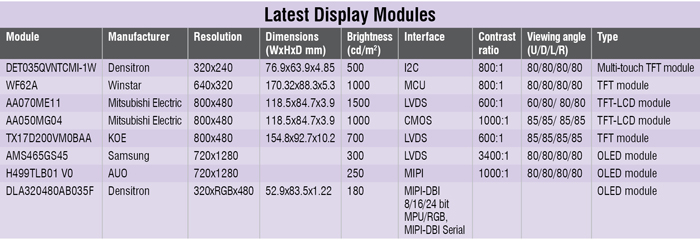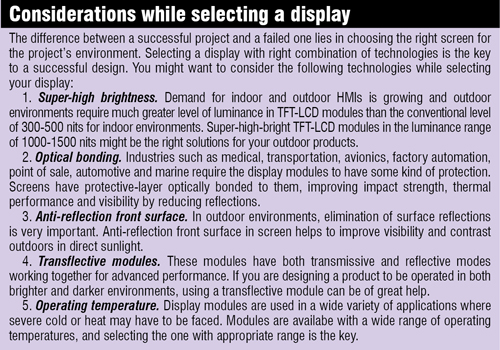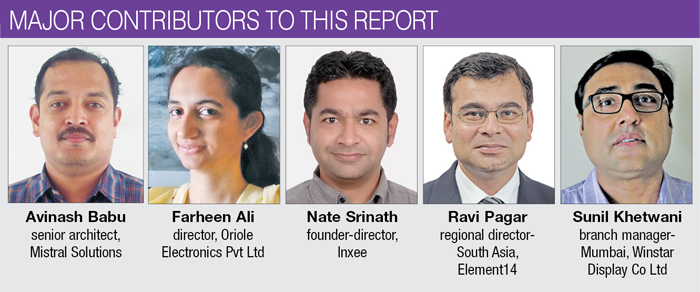We have all seen the transition from CCFT- to LED-backlit LCD modules, and the many benefits it provides for design engineers working on incorporating display technology into their devices. Modern displays, such as TFT and OLED, are evolving with promising designs for tomorrow, including the integration of new high-speed interfaces to handle the emergence of very-high-resolution imaging needs and the possible elimination of backlight in E-Ink displays. Overall, displays for embedded systems have evolved well enough to help design efficient and better products, often directly affecting the duration of the design cycle itself. Let’s see how.
Ready-to-deploy solutions
The choice of which embedded display to use could be a complex decision to figure out, especially for those who are new to integrating an embedded display into their design. Vendors have announced new all-in-one display products that cater to the requirements of a design engineer developing from industrial to consumer applications, with the main aim being to make the design process faster. These displays are engineered to integrate anything from power supplies to integrated processors. They include all the necessary components and integrate various functions like switch, UART, USB, SPI, I2C and PWM, along with SD card storage, to allow for large storage capabilities.

Ravi Pagar, regional director–South Asia, element14 India, says, “The all-in-one offerings reduce time-to-market and development costs. Engineers can quickly integrate multiple functionalities into their next design and also upgrade their designs, quite simply. These ready-to-deploy solutions can be adopted for products in various areas like industrial, consumer electronics and telecommunications.”
Upgrade for mono STN LCD modules: If you do not have much experience on TFT module development, and you want to upgrade your mono LCD display to a TFT, there is no need to worry about microcontroller unit (MCU) limitations. TFTs with integrated processors are available for upgrading mono displays to colour TFT displays, saving R&D engineers time and accelerate the product development procedures.

These latest ‘clever’ TFTs do not require any modification to the existing firmware and circuit on your PCB. For instance, Winstar’s WF35M allows the designer to implement colour TFT without having to redesign the TFT firmware and circuit. You can easily switch to TFT with a simple procedure, avoiding too many I/O, without using an expensive high-performance CPU or MCU. These TFTs eliminate the need for using FPC at the client’s end, thereby adding to the savings for your bill of material (BOM) costs for final products.

Onboard video processing for easier integration. Systems having a combination of video processing functionality built directly into the screens have made it possible for easier integration with a number of applications. These display modules, like 4D System’s 4DLCD-FT843 and FTDI’s VM800B, are highly advanced intelligent SPI displays, based on integrated video engine and amplifier-enabled audio, providing low-cost display solutions for your embedded designs.
The integrated engine offloads the host processor and provides a variety of graphics features. Besides, various interfacing options allow different hosts to be connected directly to the displays, providing a powerful set of audio and graphics features to the host using the on-board audio/video engine. These modules are best suited for requirements of various HMI applications, including industrial control terminals, intelligent instruments, data acquisition and analysis, medical products and network terminals.
TFTs with enhanced optics
Displays combining exceptional projected-capacitive-touch (PCT) technology with industrial-grade TFTs are able to offer higher transmissivity and unlimited controller-dependent multi-touch capability. Now we have a combination of high resolutions with extremely compact form factors up to depths as low as 4.6mm, enabling the design of even thinner devices or providing space for integrating more components.

Modules like those in Densitron’s DET035QVN series have improved TFTs with ultra-wide-view (UWV) polariser solution, increased viewing angles in each direction with greatest colour consistency, which is well suited for use in high-end, graphics-rich applications, for both fixed and mobile devices. And they consume as low as 2.8W.
If we talk about mono TFTs, the latest monochrome models with TN-positive LCD applied in the active-matrix TFTs are able to provide brightness as high as 1000-1500 nits, and high contrasts as much as 800:1 with short response times. These models, like the Winstar’s Mono WF57S, are superior alternatives to traditional monochrome LCD modules.
Thin-glass substrate EPD. Based on new thin-glass TFT technology, the latest E-Ink or electronic paper display (EPD) modules are catering to the demands of portable consumer electronics products that are much lighter and thinner as compared to other standard displays. These weigh around 50 per cent lighter than an equivalent glass-based TFT and are 50 per cent thinner.
In addition to being thin and light, these modules deliver the same energy efficiency and daylight readability of all E-Ink displays. Besides, the energy efficiency further reduces weight of the end products by requiring a much smaller battery.
Flexible active-matrix displays for wearable electronics. MOBIUS is another E-Ink technology that is mainly used by smartwatch start-ups like Sonostar and Transmart for designing flexible wearable display solutions. MOBIUS-based modules are smaller version of displays based on flexible-TFT technology. Lightweight and rugged properties make them conformable, so the end product has a better fit for the consumer.
With the inherent power management capability, these EPD modules are ideal for lightweight portable products that require a large display surface. Also, if you only want to display some numbers, and those numbers change very infrequently, no point in refreshing the display every time to burn power.
OLED technology for high-end mobile devices
OLED technology has been around for quite some time, but now it is evolving with more advanced features and physics, promising to be the technology for the future designs. OLED displays are improving at a very impressive rate of about 20 per cent or more year-on-year in brightness, colour management, colour accuracy, resolution, PPI and power efficiency.
OLED technology has many advantages over the other display technologies in terms of performance as well as power. Avinash Babu, senior architect, Mistral Solutions, explains, “People are slowly moving the display technologies to OLED-based technology. An OLED-based display generally helps the designers in terms of having a better contrast, it is lightweight and it consumes less power. If you see the viewing angle as well, it is better in OLED as compared to TFT.”
Flexible and curved OLED modules. Special OLED solutions are available for design engineers, making it possible to have curved and flexible displays for the futuristic designs. It is one of the major and important innovations in the display world, helping to design better and efficient displays. The popular Samsung YOUM line of displays targets designers of smartphones and wearables.
Curved surface significantly reduces, and sometimes even eliminates, reflections from ambient light sources. This not only improves screen readability and image quality but also allows the displays to run at lower brightness, thereby increasing their power efficiency and battery-running time. These OLEDs, being incredibly thin at just a fraction of a millimetre, along with the curved and flexible surfaces, are a suitable choice for mobile displays and the trending wearable displays.
Even higher resolution and brightness. As if resolution on current Samsung Galaxy S5 wasn’t enough, many vendors have introduced even-higher-resolution AMOLED panels and modules. One example is AUO’s WQHD AMOLED panel with 2560×1440 resolution at 513PPI. But vendors like Sharp, Samsung and SDC have gone further and announced resolutions of 560, 664 and even 860PPI. Apart from high resolution, ultra-slim designs up to 0.57mm have been realised and special drivers are being integrated to increase their touch sensitivity.
Using new structure and new OLEDs, manufacturers have come up with high-brightness PMOLED modules, which mainly target the increasing demand for wearable devices. These new OLED modules offer unparalleled clarity, even in direct sunlight, featuring a luminance of 1000 nits, which is nearly ten times of that available with average OLED modules.
The only challenge for OLED technology is the manufacturing cost and yield. Though OLEDs have many benefits associated with them, manufacturing of OLEDs is still lacking behind in terms of productivity. Nate Srinath, founder-director, Inxee says, “Cost of manufacturing OLEDs is much higher than LCDs, and also people still don’t appreciate their significance. The major challenges for OLEDs are reducing production costs and increasing production capacities.”
Light capturing cavities in numeric displays
Demand for compact and efficient products has resulted in more compact and space-saving designs in 7-segment numeric displays, like those found in Lumex LDP-2R2608RD-50 series. These latest LED-based offerings use the brightest chip technology and light-capturing cavities, which allows them to offer maximum brightness and legibility without sacrificing any colour intensity or uniformity.
These single-package designs with multiple digits and icons can display any type of word or icon due to the display overlay. If you are looking for displays for board or panel indication, telecom switches and central station equipment, control panels with high-brightness lighting, these compact solutions might be the answer.
Developing displays for embedded systems
There are various standard low-cost display development kits available to aid your designs. These kits not only have the required hardware like display module, cables, controllers and power supply but also the reference manuals and codes (if required) to program your modules. You can also have live online support for working with the kits. Some vendors provide an exclusive GUI web-portal development site license along with their kits to help design engineers with an advanced approach to web-based development.

Using the latest hot pluggable USB-based OLED development kits, you can drive OLED displays from the USB port of a PC. These are extremely easy to use yet powerful demonstration tools that do not require any extra cable or power supply to run, allowing displays to be up and running in minutes. A kit will provide you with a USB controller card, mini USB cable, an interchangeable OLED display card and a CD with software application and drivers. Also available are the display expansion boards and capes for various development board environments. Besides, some vendors provide customised solutions with kit modules to quickly interface the display module to your Raspberry Pi or Arduino-compatible board.
If you are working with E-Ink displays, there are easy-to-use PC USB powered kits based on open source software and tools. The latest EPD kits include pre-loaded firmware to take data via USB that are later sent over to the extension boards.
Future: LED displays with high resolution
When we talk of LED displays, these are not true LEDs. These are LCD displays with LED backlights. Nate Srinath says, “Till date we haven’t perfected an LED display with very high resolution.”
We can increase features in TFT-LCD technology and make power-efficient designs, but we have to look for advancements in greener technologies like LED and OLED for the future. Previously it was possible to make only small OLED displays, but over time manufacturers have started making the process more efficient. They are now able to make larger displays, but still the cost-efficient yield of OLEDs has to be achieved.
Experts believe that true LED displays with high resolution can be more power-efficient with a high contrast and brightness coming as natural features. However, can we actually have high resolutions with true LED displays?
Nate Srinath, founder-director, Inxee says, “It is possible with manufacturing capability changes. Today we can’t manufacture an LED lamp smaller than a particular dimension. So we have to improve upon that and make smaller and smaller LEDs to hit extremely minute dimensions and be able to control them individually with good spectral characteristics. This will eventually lead to displays that will be very rugged and extremely modular. You can build your own giant flat-screen TV using smaller modules. Even if you throw water or stones on them, or break a pixel, it will continue to operate. Maybe 4-5 years down the road, we will be able to see such displays.”








Hello sir,
I want USB based OLED development kits may i know the vendors provided these kits and if required i also need certain display modules used in present embedded systems.
Let me know more about led display unit